As you commence underground utility construction, remember that precise mapping is your initial step towards avoiding costly setbacks. By integrating Ground-Penetrating Radar (GPR) and GIS technologies, you'll accurately locate existing utilities, reducing the risk of interruptions. This approach not only streamlines the planning phase but also guards against potential hazards. Now, consider how thorough risk assessment and stakeholder engagement can further refine your strategy and propel your project forward.
Assessing Site Conditions and Challenges
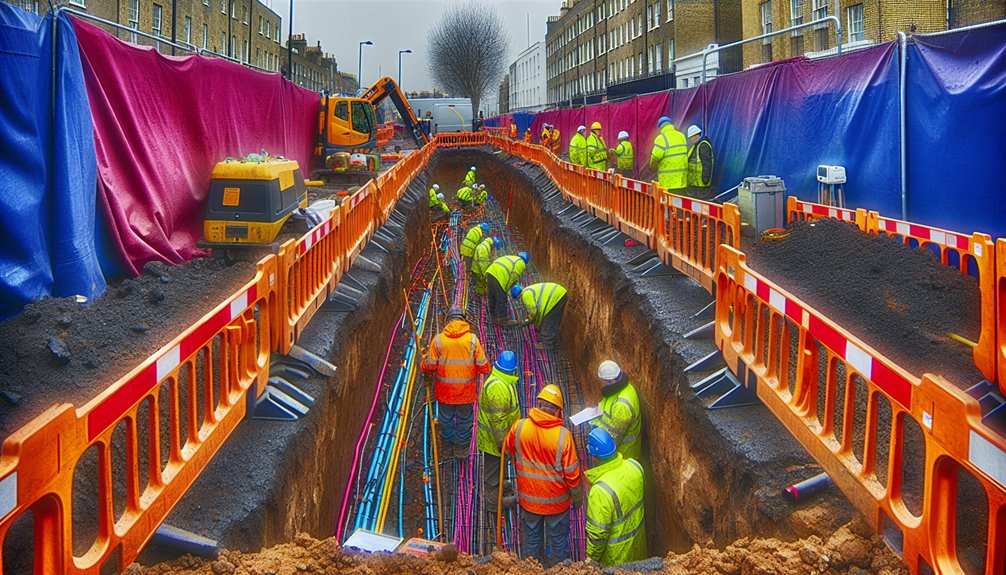
Before you break ground on a new project, it's vital to thoroughly assess site conditions and challenges.
Begin by conducting initial site surveys to identify underground utilities. You'll need to collect and integrate existing utility data from records, blueprints, and official maps.
Employ GIS underground mapping software to generate accurate 2D and 3D maps pinpointing utility locations. It's important to determine the risk levels associated with each utility to plan safe excavation zones.
Collaborate closely with utility companies to guarantee extensive mapping. This step not only bolsters excavation safety but also streamlines your project planning, preventing costly disruptions and guaranteeing compliance with relevant regulations.
With the use of advanced GIS underground mapping software, you can also create dynamic visual representations that further enhance project planning and safety measures.
Thorough assessment and utility mapping are your keys to a successful project launch.
Utilizing Precise Mapping Techniques
As you shift from evaluating site conditions to the actual mapping of underground utilities, it's crucial to select the best mapping techniques that align with your project's specific needs.
Quality Level A mapping, using high-accuracy technologies like Ground-Penetrating Radar (GPR) and vacuum excavation, guarantees data accuracy and excavation safety, though it may impact your project timelines due to its thoroughness.
For cost efficiency, consider integrating Quality Level B methods, which employ electromagnetic locators and acoustic methods for effective utility identification without extensive digging. This approach is instrumental in reducing unexpected subsurface discoveries that can lead to costly delays.
Leveraging cloud-based data collection and asset management software not only streamlines compliance standards but also enhances risk assessment capabilities, guaranteeing your project adheres to safety and regulatory mandates while optimizing operational efficiency.
Implementing Risk Management Strategies
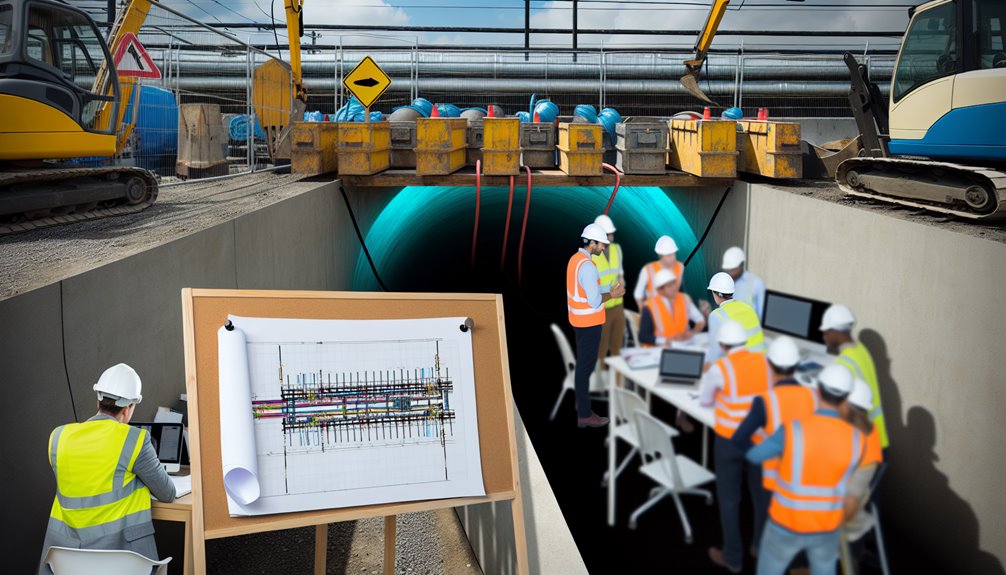
As you implement risk management strategies, it's essential to first identify potential hazards using tools such as Ground Penetrating Radar (GPR) and risk assessment matrices.
Once identified, you'll need to develop thorough mitigation plans that adjust construction approaches and incorporate robust safety measures.
This proactive approach guarantees that risks are managed effectively from the design phase through to project completion.
Identify Potential Hazards
Why should you prioritize identifying potential hazards in your project planning? Recognizing risks related to utility damage is essential. Damaging gas, electrical, or water lines not only leads to service disruptions but also poses serious safety threats, such as explosions or electrocutions.
Utility identification and hazard awareness are indispensable. Advanced GIS and precise land surveying are your tools to map underground utilities accurately, avoiding misguided digs.
Furthermore, environmental shifts like heavy rainfall or earthquakes can alter the landscape, making previous utility mappings unreliable. By staying vigilant about these changes, you'll mitigate risks effectively.
Always guarantee your team's familiar with safe excavation practices and equipped with the right tools to prevent accidental utility strikes, safeguarding both personnel and infrastructure.
Develop Mitigation Plans
Once you've identified potential hazards, it's vital to develop thorough mitigation plans to manage these risks effectively.
Employ advanced technologies such as Ground Penetrating Radar (GPR) and utility locating services to enhance detection and mapping accuracy. This integration aids in precise risk scoring and supports the deployment of mitigation techniques focused on risk reduction.
Utilize digital maps to transfer vital data directly to physical markers, ensuring clear communication among your team.
Systematically assess risks using models that quantify and prioritize them, enabling focused mitigation on the most critical areas.
Develop detailed operational procedures and internal controls to reduce the likelihood or impact of these risks, and keep contingency plans ready for swift response to unexpected incidents.
Engaging With Regulatory Compliance and Permits
Engaging effectively with regulatory compliance and securing the necessary permits are foundational steps in project planning that you can't overlook.
You must stay abreast of regulatory updates like ASCE 38-22 and ASCE 75-22 to guarantee your urban utility mapping meets stringent standards. Steering through state, local, and federal regulations requires a meticulous understanding of permit timelines to avoid costly delays and legal issues.
Before you dig, coordinate with regulatory bodies to align your project's design with compliance requirements, streamlining the permit process.
Choosing the Right Equipment and Technology
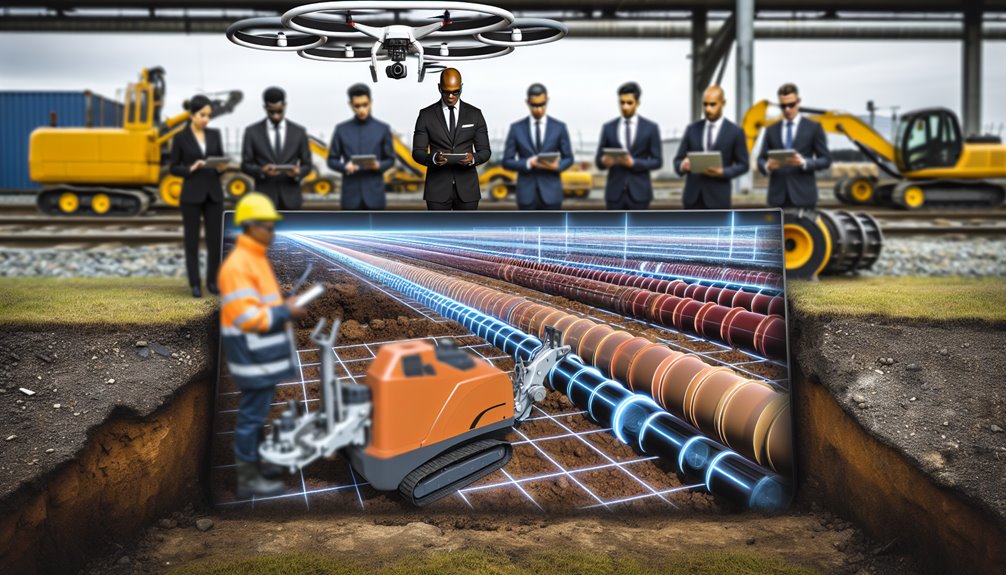
Selecting the right equipment and technology is essential for efficient project execution and minimizing risks associated with underground utility work.
You'll want to choose utility locating devices like Ground-Penetrating Radar (GPR) and Electromagnetic Locators for their specific capabilities in detecting various utility types. Integration of real-time mapping and digital documentation streamlines data handling, enhancing accuracy in your planning stages.
For excavation, Horizontal Directional Drilling (HDD) and Vacuum Excavation are prudent choices, particularly in sensitive areas where precision is paramount.
Equipment selection should also consider advanced technology integration such as AI and IoT sensors, which boost predictive and real-time monitoring capabilities. These integrations not only refine your operational efficiency but also greatly mitigate potential hazards and disruptions.
Training and Safety Protocols for Crews
You'll need to implement thorough safety training programs to guarantee your crews are well-versed in preventing damage to underground utilities and maintaining personal safety.
It's vital that you also establish robust emergency response procedures, including clear steps for immediate incident reporting and engagement with emergency services.
These practices aren't just regulatory; they're fundamental to safeguarding your team and the infrastructure you work on.
Safety Training Programs
To guarantee compliance with OSHA Standard 29 CFR Part 1926 Subpart P, your safety training program must cover essential elements such as soil evaluation, protective systems, and accurate interpretations of safety standards.
To enhance safety compliance and training effectiveness, consider these innovative approaches:
- Interactive Learning: Utilize virtual reality simulations to replicate real-world hazards and decision-making scenarios.
- Competency Checks: Incorporate frequent knowledge assessments to ascertain understanding and retention.
- Flexible Formats: Offer training via in-person, virtual, and e-learning platforms to accommodate different learning styles.
- Engagement Tools: Employ apps like the United Rentals Trench Safety app for continuous learning and onsite reference.
These strategies won't only meet regulatory requirements but also foster a culture of safety and innovation within your teams.
Emergency Response Preparedness
Developing a robust emergency response plan is critical for guaranteeing the safety and preparedness of your crew in crisis situations.
You'll need to integrate detailed evacuation routes, clearly defined roles, and reliable communication protocols. Regularly conducting emergency drills reinforces these protocols and guarantees everyone knows their responsibilities.
Make sure department heads are equipped to track all personnel during these drills, confirming that everyone reaches the designated safety zones efficiently.
Innovate by implementing advanced IoT devices for real-time monitoring and utilize subsurface utility mapping software during emergencies to enhance situational awareness.
Continuously update and refine your plans, focusing on practical, real-world applications of technology to optimize your team's response times and safety measures during unexpected events.
Scheduling and Workflow Optimization
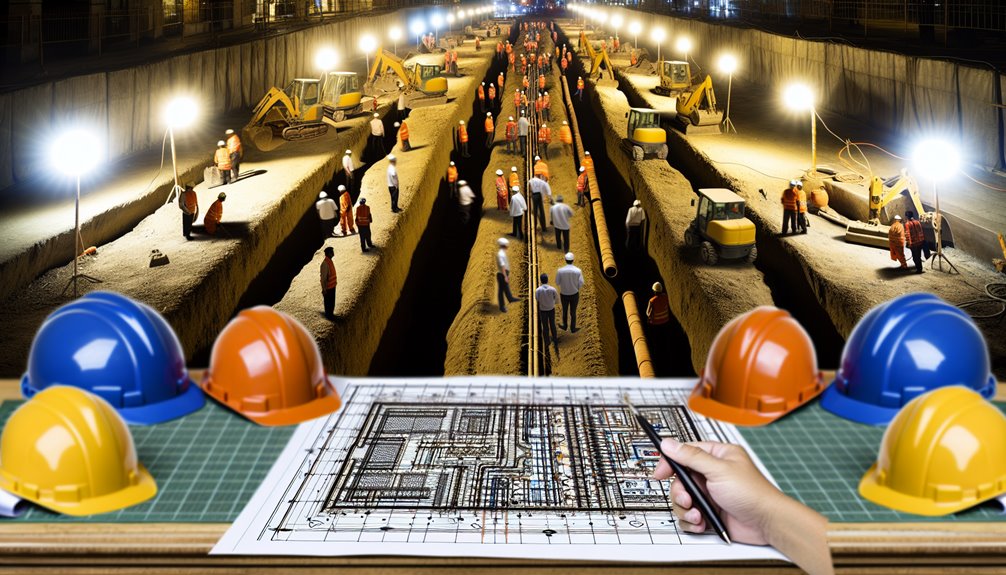
While optimizing your project schedule, don't overlook the importance of effective workflow management.
Integrating advanced scheduling techniques and workflow strategies is essential. Here's how you can refine your approach:
- Utilize simulation modeling software to anticipate and mitigate potential disruptions, enhancing reliability.
- Implement cyclograms with detailed time steps to monitor and adjust the daily work plan meticulously.
- Conduct parameter variation experiments to identify best scheduling configurations, reducing project completion time.
- Collaborate closely with utility stakeholders through regular updates and meetings, ensuring alignment and swift adaptation to changes.
Managing Environmental Impact and Mitigation
As you shift from scheduling to environmental considerations in project planning, it's crucial to address the impact of construction activities on the environment and implement effective mitigation strategies.
Start with accurate utility locating to avoid damaging critical infrastructure like sewage and chemical lines, preventing soil and water contamination. Adopt sustainable excavation methods that include using clean fill materials and paving to minimize ecological disruption.
Focus on ecological preservation by conducting thorough environmental impact studies, particularly in sensitive areas. Implement soil erosion control techniques and guarantee compliance with local environmental regulations.
Always restore the site to its original condition, promoting both environmental health and community safety. By taking these steps, you'll mitigate environmental risks effectively while advancing your project goals.
Stakeholder Communication and Community Relations
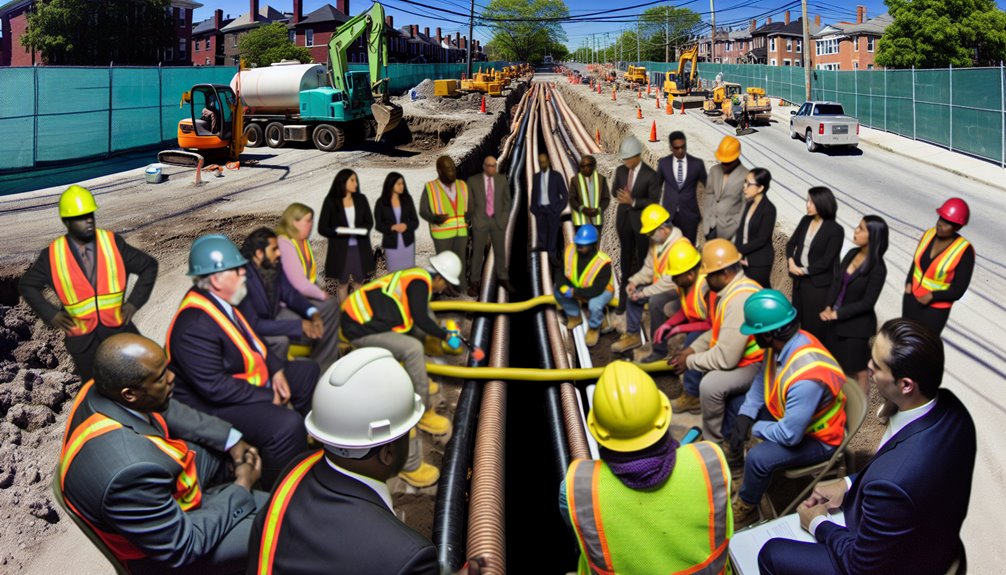
To guarantee the success of your project, establishing effective communication protocols and fostering robust community relations are essential.
Effective stakeholder engagement begins with clear, ongoing communication and involves every key player from the outset.
Here's how you can enhance both stakeholder communication and community relations:
- Utilize Advanced Technologies: Implement tools like Utilocate for real-time data sharing, enhancing transparency and reducing conflicts.
- Regular Stakeholder Meetings: Hold frequent updates and coordination meetings to keep all parties aligned and informed.
- Community Feedback Channels: Open multiple lines for community input and address concerns promptly to build trust and support.
- Inclusive Planning Sessions: Involve community representatives in the planning phases to guarantee their interests are integrated into your project strategy.
Implementing these strategies will guarantee smoother project execution and stronger community support.
Conclusion
As you finalize your underground utility construction project, guarantee you've thoroughly assessed site conditions and utilized precise mapping techniques. Implement robust risk management and adhere strictly to regulatory requirements. Select appropriate technology and equipment, prioritize crew safety through meticulous training, and optimize your scheduling for maximum efficiency. Always manage the environmental footprint responsibly. Most importantly, maintain open lines of communication with all stakeholders to foster trust and facilitate smoother project execution.
If you'd like to learn more about best practices in underground utility construction, I invite you to visit Boring Bros at boringbro.com or give us a call at (954) 639-6167. We'd love to share our insights and help you on your project journey!

